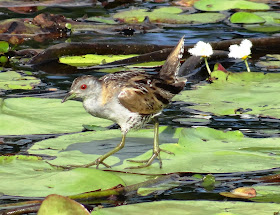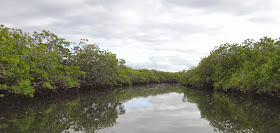 |
| Dowitcher site - North Pine River |
An Asian Dowitcher was reported last Sunday by Andy Jensen on the North Pine River near the Osprey House Environmental Centre, in the same place where an Asian Dowitcher was seen in June.
 |
| Lousy image of Asian Dowitcher |
When I visited the spot yesterday I found not one but two Asian Dowitchers. Andy's directions are spot on. The birds are best viewed from the mudlfats on the southern shore of the river after walking a short distance through mangroves from the lay-by on a sharp bend of Dohles Rocks Road. This spot is where the road first meets the mangroves - a few hundred metres back towards the Bruce Highway from Osprey House. Beware: the mud can be very deep and sticky here.
The dowitchers were quite distant but seen easily through a scope. Unlike other waders there, they kept well back from the water edge, feeding along the line of exposed mangrove roots. The tide at the time was low but turning. A combination of distance and foreground interference meant I managed only lousy images, such as the one above.
Here is a better one, taken by Ian Montgomery at Cairns. For some time after my arrival at the North Pine River, I saw just a single dowitcher, but later a second bird emerged. At times they foraged together but mostly they were apart, and not associating particularly with other waders. I noticed that the dowitchers fed backwards and forwards along the mangrove root line, keeping within a fairly restricted area perhaps 150 metres long.
 |
| Whimbrel |
The only other waders present were a few Eastern Curlews, Bar-tailed Godwits and Whimbrels, along with a couple of Grey-tailed Tattlers and a single Marsh Sandpiper.
POSTSCRIPT
I returned to the North Pine River site today (December 12) to kayak to the mangroves behind where the dowitchers were seen in the hope of obtaining better photographs, as it seemed the birds were wedded to foraging in a fairly restricted area.
 |
| Black-tailed Godwit |
No sign of the dowitchers unfortunately. However, other waders present were very different from a few days ago. Today there were good numbers of Black-tailed Godwit, Red-necked Stint, Red-capped Plover, Pacific Golden Plover and Common Greenshank, none of which I saw earlier in the week.
 |
| White-faced Heron |
In other forays, I kayaked the Tewantin section of the Noosa River and saw Black Bittern on three occasions over a period of a couple of hours. After I left the kayak to walk around Sheepstation Island, I was surprised when a bittern I flushed from the bank at very close quarters dived into the water. Its head and neck appeared above the water, darter-like, before the bird disappeared. I would be interested in hearing if others have heard of similar behaviour. I am not sure if I saw one or more bitterns overall. The bitterns would not allow themselves to be photographed, so a heron had to do.
A male Shining Flycatcher was seen in the mangroves and two other single flycatchers were heard.
 |
| Boebuck |
Some images closer to home, in the garden at Ninderry. The Boebuck and her now well-grown young continue to play havoc with the bird feeders.
 |
| Eastern Grey Kangaroo |
A sub-adult male Eastern Grey Kangaroo has moved in, drinking the bird bath dry here.
 |
| Green Catbird |
This catbird showed well, along with a few other nice birds.
 |
| Eastern Yellow Robin |
 |
| Pale-headed Rosella & White-headed Pigeon |











+goshawk.JPG)
















































